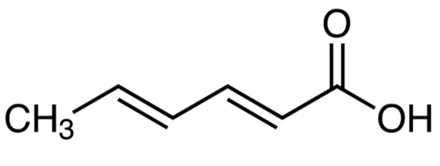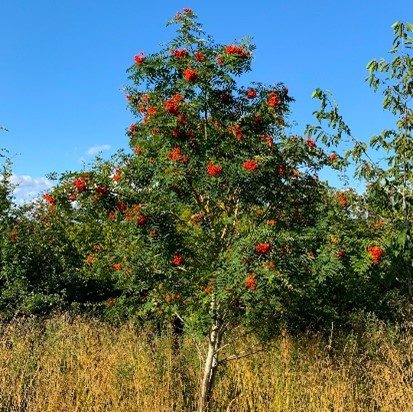
Sorbic acid is a natural organic compound commonly used as an antimicrobial agent in food and drinks to prevent the growth of mold, yeast, and fungi.
Natural Sources of Sorbic Acid:
Sorbic acid is found naturally in the berries of the mountain ash (rowan) tree, from where it was first obtained in 1859 by distillation of rowanberry oil.


The tree can be found far north into Scandanavia. Flowers appear from May to June and the fruit ripens from August to October. Not only are the fruits of the Rowan tree edible, they are a rich source of carotenoids, Polyphenols, Flavonols organic acids and other bio active compounds [1, 2].
Mechanism of Action:
The antimicrobial action of sorbic acid is due to its inhibitory influence on various enzymes in the microbial cell. The enzymes inhibited by sorbic acid include the following [3]:
1. Enzymes involved in carbohydrate metabolism such as enolase and lactate dehydrogenase.
2. Enzymes of citric acid cycles such as malate dehydrogenase, isocitrate dehydrogenase, ketoglutarate dehydrogenase, succinate dehydrogenase, and fumerase.
3. Several enzymes containing SH group, and other enzymes such as catalase and peroxidase.
The antimicrobial action of sorbic acid is most effective when it exists in its undissociated form. With a pKa of 4.75, sorbic acid’s inhibitory influence rises as the pH level decreases below this point. This is because the proportion of undissociated sorbic acid surpasses 50% at pH values lower than 4.75, resulting in enhanced antimicrobial activity [3].
| pH | % undissociated acid |
| 7,00 | 0,6 |
| 6,00 | 6,0 |
| 5,80 | 7,0 |
| 5,00 | 37,0 |
| 4,75 | 50,0 |
| 4.40 | 70,0 |
| 4,00 | 86,0 |
| 3,70 | 93,0 |
Safety Information Summary:
| LD50 Oral | 9600 mg/kg | [4] |
| LD50 Dermal | >2000 mg/kg | [4] |
| NOAEL | 300 mg/kg bw/d | [5] |
| Skin irritant | Irritating to the skin | [4] |
| Eye Irritant | Irritating to the eyes | [4] |
| Mucous membrane irritation | Negative | [6] |
| Skin sensitization | Negative | [6] |
| Mutagenicity | Negative | [4] |
[1] Arvinte, et al., “Rowanberry—A Source of Bioactive Compounds and Their Biopharmaceutical Properties”, Plants, vol 12 (18), 2023, pp. 3225
[2] Cristea, et al.,“The Influence of Temperature, Storage Conditions, pH, and Ionic Strength on the Antioxidant Activity and Color Parameters of Rowan Berry Extracts”, Molecules, vol 26 (13), 2021, pp. 3786
[3] M. Dharmadhikari, “Sorbic Acid”, Midwest Grape and Wine Industry Institute, 202
[5] Younes et. Al., “Opinion on the follow-up of the re-evaluation of sorbic acid (E200) and potassium sorbate (E202) as food additives”, EFSA J., vol 17 (3), (2019), pp. e05625
[6] Sorbic Acid, Material Safety Data Sheets (MSDS), W392103, Sigma Aldrich Chemie GmbH, Riedstrasse 2, Steinheim, Germany, D-89555 03.01.2024
